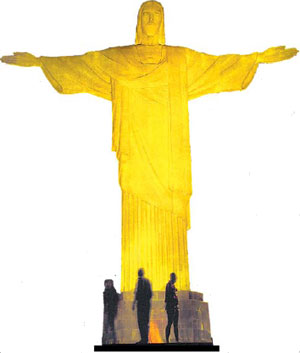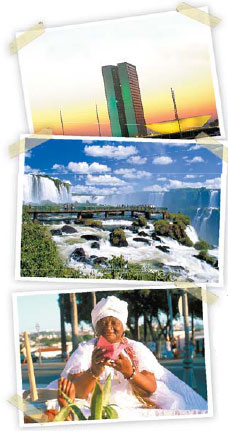Did you know...?

Brazil is the world's fifth largest country. It covers a much larger area than Western Europe, and is slightly bigger than the United States, excluding Alaska.
Brazil shares a border with every other country in South America apart from Ecuador and Chile - eleven in total - and has lived in peace with all of them for almost 140 years. (The last South American war involving Brazil was the conflict between Paraguay and the "Triple Alliance" in the 1860s.)
It is estimated that Brazil contains greater biodiversity than any other country on Earth. The rivers of the Amazon region, for example, are home to more than 1,500 different species of fish.
The Amazon river, most of which lies within Brazil, could be the longest in the world. The discovery in 2007 of what appears to be the Amazon's true source - in southern rather than northern Peru - would give it a total length of 4,250 miles, about 90 miles more than the Nile.
With more than 185 million people, Brazil is the world's 5th most populous country after China, India, the United States and Indonesia.

Its population is currently growing by approximately 1.5 percent per year - a lower rate than in most other developing countries. By 2015, according to current projections, Brazil will have been overtaken by Pakistan as the 5th most populous country.
Brazil has the world's second biggest black population after Nigeria, the largest number of people of Japanese ancestry outside Japan, and more people of Lebanese or Syrian extraction than the combined populations of Lebanon and Syria.
Brazil has an indigenous Indian population of around 450,000, comprising more than 200 peoples who speak more than 180 different languages. According to the National Foundation for the Indian (FUNAI), the indigenous population has been growing at a rate of more than 3.5 percent per year and is now four times greater than in 1950.
FUNAI also estimates that in the Brazilian Amazon there are more than 60 "uncontacted" Indian groups living in complete isolation from the outside world. Government policy is to avoid contact with such groups unless they are in extreme danger.
More than 80 percent of Brazilians live in urban areas. So Paulo, in the south-east of the country, is the biggest and most populous city in the Southern Hemisphere. The population of the city proper is around 11 million, and the adjacent metropolitan areas are home to a further 18 million. The urban region as a whole is therefore the second most populous in the world, after Tokyo.
Brazil has the 9th biggest economy in the world in terms of Gross Domestic Product (GDP) derived from purchasing power parity (PPP) calculations.
The Brazilian company Embraer is the world's third biggest aircraft-producer and exporter after Boeing and Airbus. It specializes in "regional" jets - medium-sized planes that seat up to 110 passengers.
Brazil is the world's largest exporter of sugar, coffee, orange juice, soya, beef, tobacco and chicken. In terms of agriculture, the Financial Times describes the country as "a powerhouse whose size and efficiency few competitors can match."
Against a backdrop of rising concerns about climate change and declining oil reserves, Brazil has become a pioneer in the production of ethanol (produced from sugarcane) and other biofuels. More than three-quarters of the automobiles sold in Brazil have flex-fuel engines, capable of running on petrol, ethanol, or a mixture of the two. Biofuel can be produced from castor beans, oil palms, sunflowers, babacu nuts, peanuts, jatropha and soya. Brazil anticipates that it will be producing biofuel at a rate of 1 billion liters per year by the end of 2007.
The rate of deforestation in the Amazon region has fallen sharply since 2004. Deforestation from mid-2004 to mid-2005 was 32 percent lower than over the previous twelve months, and there was a further decrease of 11 percent in 2005-06. Overall, approximately 15 percent of Brazil's territory is covered by virgin forest.
Brazil is participating in the biggest ever scientific project entailing cooperation between different countries - the International Space Station (ISS). In March 2006 the astronaut Marcos Pontes became the first Brazilian (and the first native Portuguese speaker) to go into space when he embarked on a mission to the ISS. He stayed there for a week, performing experiments involving nanotechnology and biotechnology.
Brazil has the only source of synchrotron light, which permits the study of atoms and molecules, in the southern hemisphere. The equipment - developed, built and operated entirely by Brazilians - belongs to the National Synchrotron Light Laboratory in Campinas, So Paulo state.
Brazil has become the world's leading source of satellite images, due to the government's policy of providing users in Brazil and neighboring countries with free access to the images produced by the Sino-Brazilian Earth Resources Satellite.
In 2000, a team of scientists based in So Paulo achieved the first ever sequencing or 'decoding' of the genome of a plant pathogen. The bacterium in question was the insect-borne Xylella fastidiosa, which infects citrus fruit and other commercially important produce.
Brazil's Aids program is widely seen as a model for other developing countries. In the early 1990s the World Bank predicted that 1.2 million Brazilians would have HIV-Aids by 2000. The current number, however, is around 650,000, and is rising only very slowly.
The annual number of Aids-related deaths has fallen sharply. Brazil is one of the few countries that provide free anti-retroviral medicines to those who are HIV-infected, and the government has also applied pressure on a number of international pharmaceutical companies in order to reduce the prices at which it buys anti-retroviral drugs. The government also places great emphasis on prevention, with education and publicity campaigns actively and openly promoting safe sex among high-risk and vulnerable groups, including prostitutes and adolescents.
Brazilian national Oscar Niemeyer is universally considered one of the most important figures in international modern architecture. Apart from being the major influence on the construction of Braslia, Brazil's new capital, in the late 1950s, he has also designed numerous important buildings in other countries - including the United Nations headquarters in New York. Even though he is now in his late nineties, he continues to work five days a week in his office in Copacabana, Rio de Janeiro.
Since 2003, Brazil has been hosting an annual international literary festival in the colonial town of Parati in Rio de Janeiro state, which attracts a large number of famous participants. Salman Rushdie, Ian McEwan, Margaret Atwood, Martin Amis, Christopher Hitchens, Toni Morrisson and Eric Hobsbawm are among past attendees.
The most famous of the gentle bossa nova melodies of the 1950s and 60s, The Girl from Ipanema, written by Antonio Carlos ("Tom") Jobim and Vinicius de Moraes, is generally thought to be among the five most-played pieces of music (either live or on the radio) in the world.
The annual carnival in Salvador, capital of the state of Bahia, is the world's biggest street party, attracting around 2 million people (including an average of 800,000 Brazilian and foreign tourists). The music is provided by mobile sound systems (trios eltricos) and over a hundred parade groups (blocos).
The first person to make an 'unassisted' flight in an aircraft, that is, a heavier-than-air machine, not a balloon, was the Brazilian Albert Santos-Dumont, who piloted the 14 Bis over a distance of about 60 m, at the modest altitude of 2-3 m, in Paris on 23 October, 1906.
The Wright brothers had flown a similar distance in the United States in December 1903, but in order to become airborne their machine required launch rails and a catapult.
The city of Rio de Janeiro throws a New Year's Eve party that is probably the biggest - and arguably the most spectacular - in the world. Around two million people, all of them dressed at least partly in white (a popular tradition adopted from Afro-Brazilian religion), congregate on the huge crescent-shaped expanse of Copacabana beach to watch a midnight fireworks display.
Rio also gets into the record books with its Christmas festivities: the city's 82-m high artificial Christmas tree (a conical metal framework covered in lights), which floats in the middle of Rodrigo de Freitas Lagoon near Ipanema beach, is the biggest of its kind in the world.

(China Daily 09/07/2007 page28)














